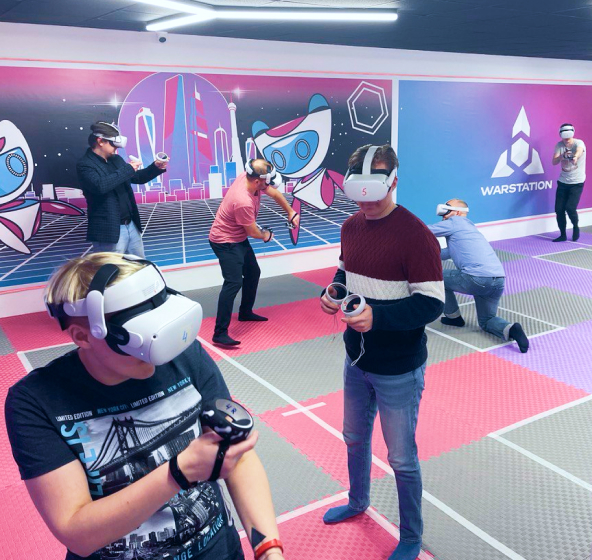What is needed to
open a VR arena?
1. Premises
The first thing to consider is finding suitable premises. Here are some important characteristics to consider for a successful VR arena.
Required specifications:
✓ Adequate space
A VR arena should have enough space to provide enough room for players to move around safely without hitting walls or each other. The space should also be large enough to allow for a comfortable and immersive experience for players.
We recommend:
For 6 players:
- Minimum 120 m² (about 1,300 ft²)
- Optimum 150 m² (about 1,600 ft²)
For 8 players:
- Minimum 160 m² (about 1,700 ft²)
- Optimum 200 m² (about 2,150 ft²)
For 12 players:
- Minimum 240 m² (about 2,600 ft²)
- Optimum 300 m² (about 3,200 ft²)
For 14 players:
- more than 280 m² (about 3,000 ft²)
- recommended 350 m² (about 3,800 ft²)
Therefore, a minimum of 20 m² (about 215 ft²) per player is required, with a recommended size of at least 25 m² (about 270 ft²). However, the larger your location, the more interesting and diverse your virtual world will be for players. Therefore, ideally, you will need premises of 250 m² (about 2,700 ft²) of gaming space plus a reception area.
✓ Large passing trade traffic.
The premise should be located in the places that have the largest passing trade traffic in city malls that you can find. Such places can vary depending on the specific mall and its layout, but usually the best places are Entertainment areas such as cinemas, gaming arcades, bowling alleys, trampoline attractions, and so on. Such places tend to attract a lot of foot traffic, particularly from families and young adults.
Overall, businesses that are located in high-traffic areas within malls or at Family entertainment centers are likely to benefit from increased visibility and foot traffic.
We recommend installing glass walls facing the walkway area, allowing passersby to see both the players and the TV screen displaying the current virtual world or game from the perspective of one of the players.
✓ Game Safety Features.
A VR arena should have safety features in place, such as padded walls or floors, to prevent injuries in case a player falls or collides with an object while in the virtual environment.
✓ Other Safety features.
Additionally, emergency exits should be clearly marked and easily accessible.
Ventilation.
VR experiences can be physically demanding and generate a lot of heat. Proper ventilation is important to ensure that players stay cool and comfortable while using the equipment.
✓ Recommended options.
Easy-to-Clean Surfaces.
Given that players will be moving around the space, the surfaces should be easy to clean and sanitize to maintain a hygienic environment.
Proper Lighting.
Lighting is important in a VR arena to help ensure that players can see their surroundings and avoid obstacles. The lighting should be bright enough to provide visibility but not too bright that it interferes with the VR experience.
2. Equipment
(6-12) Oculus Quest 2 headsets
(1) Game Manager Laptop
(1) Wi-Fi router connected to the internet
(1) TV screen (recommended) to display the current game for spectators
(1) water cooler with disposable cups for players
(1) Reception zone equipment (tables, chairs, clothing hangers, lockers for valuables, waiting area couch)
(1) coffee vending machine for those waiting in line or for parents waiting for their children
3. Software
WARSTATION software with a set of virtual game worlds
4. Staff
(2), one at the reception area and one instructor of the game and equipment operation.
